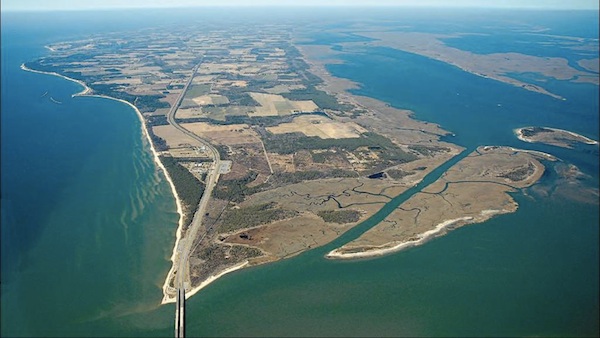Groundwater Use Could Go to 1 Million Gallons Per Day

The meteorite that hit 35 million years ago between Hampton Roads and Kiptopeke not only created the Chesapeake Bay, but also destroyed all but one freshwater aquifer, which the lower Eastern Shore depends on today.
By DORIE SOUTHERN
Cape Charles Wave
February 17, 2014
The Eastern Shore of Virginia gets all of the water used for residential development, agriculture, and industry from underground aquifers. Those aquifers were the subject of the Groundwater Summit held at Kiptopeke School last Wednesday, February 12.
About 20 attendees braved a snowstorm to attend a presentation by Britt McMillan, consulting hydro-geologist to the Eastern Shore Ground Water Committee, and Curt Smith, Director of Planning for the Accomack-Northampton Planning District Commission (ANPDC) about “Groundwater on the Eastern Shore of Virginia from Kiptokepe to Eastville.”
Two additional summits will be held with Eastville/Nassawadox/Exmore in June and communities from Belle Haven to Accomac in October.
Like most areas of the country, access to groundwater is fundamental to human activity. Agencies called upon to protect access to resources must weigh competing needs of humans for clean, fresh water with the requirements of agriculture and industry that create jobs. “Northampton County has a sustainable amount of groundwater for the foreseeable future,” Smith told the Wave.
Demand for water on the lower Eastern Shore could reach 1 million gallons per day and be sustainable even though very little rain water reaches the water table. The report noted that even with 44 inches of rain a year, only 5-6 inches makes it down to the Yorktown-Eastover Aquifer that supplies our drinking water.
CONTINUED FROM FIRST PAGE
Government agencies use multiple sources to assess groundwater quality including the U.S. Geological Survey, the Department of Environmental Quality, periodic studies by universities, the ANPDC, and the Virginia Department of Health.
Development in Northampton County continues to be influenced by a meteorite that hit the region 35 million years ago, Smith said. The first geological indications of the hit were found by scientists only about 30 years ago off the coast of Atlantic City, NJ.
The full extent of the impact was not grasped until 1993 data recovered during oil exploration revealed the location and size of the crater. The direct hit from the fireball slamming into the earth created a 25-mile-wide crater between what is now Hampton Roads and Kiptopeke.
The earthshaking impact lasted at most only days but went on to create the Chesapeake Bay over millions of years. According to Smith, the results continue to impact present-day development in Northampton and Accomac counties and contributes to sea level rise as the land continues to settle.
The meteorite destroyed all but one of the deep freshwater aquifers where it hit and went down almost a mile before it burned up. It separated the Yorktown-Eastover aquifer into two pieces, one on each side of the crater. Those aquifers lie above a deep salty brine level. It must be kept from contaminating the freshwater aquifer through saltwater intrusion. That can occur due to over-pumping of groundwater or drilling into the lower level from the freshwater level above.




















The sign at the west end of Mason Avenue tells the story of the Chesapeake Bay Impact Crater. If you went out to the end of the Cape Charles fun pier and drilled down 1,000 meters (0.6 miles) it’s very possible you would hit a pocket of (salt) water that is 145 million years old. It’s possibly the oldest traceable water on the entire planet. This pocket has supposedly been trapped down there for 35 million years. My question is: I wonder what’s floating around in it? Maybe dinosaur eggs? According to studies, the impact from the meteor would have “broken our plumbing,” so to speak, destroying the existing arrangement of fresh water aquifers and rock layers that restrict the flow of groundwater. Lucky it left us with one little vein. We all need to do the right thing to take care of it. Google “Chesapeake bay impact crater”